MACROECONOMY & END-USE MARKETS
Running tab of macro indicators: 11 out of 20

The number of new jobless claims fell by 10,000 to 201,000 during the week ending January 4. Continuing claims increased by 33,000 to 1.867 million, and the insured unemployment rate for the week ending December 28 was unchanged at 1.2%.
Nonfarm payrolls finished the year on a comparatively strong note with a higher-than-expected gain of 256,000 jobs. There were gains across most sectors, driven by services and government. The goods-producing sector of the economy lost jobs, notably in manufacturing and mining. Average hourly wages for all employees eased from 4.0% in November to 3.9% in December. The average workweek remained steady at 34.3 hours. From the separate household survey, the unemployment rate retreated slightly to 4.1%. An increase in the number of employed people absorbed new entrants into the labor force and also pulled from the ranks of the unemployed. The labor force participation rate remained steady at 62.5%.
Job openings edged slightly higher for a second month in November, up by 259,000 to nearly 8.1 million. The ratio of job openings to the number of unemployed people remained steady at 1.1. The quits rate (a measure of workers’ willingness to leave a job) moved lower.
The U.S. goods and services trade deficit widened by 6.2% to $78.2 billion in November as both imports and exports rose. Exports of goods and services ($273.4 billion) were the highest on record, imports of foods, feeds, and beverages ($19.5 billion) were the highest on record and real dollar exports of petroleum ($17.2 billion) were the highest on record. Exports of goods increased $6.2 billion to $177.6 billion in November reflecting gains in industrial supplies and materials, plastic materials, autos and parts, capital goods, consumer goods and pharmaceutical preparations. Imports of goods increased $11.6 billion to $280.9 billion in November reflecting gains in industrial supplies and materials, crude oil, capital goods, semiconductors, civilian aircraft, foods, feeds, and beverages, and autos.
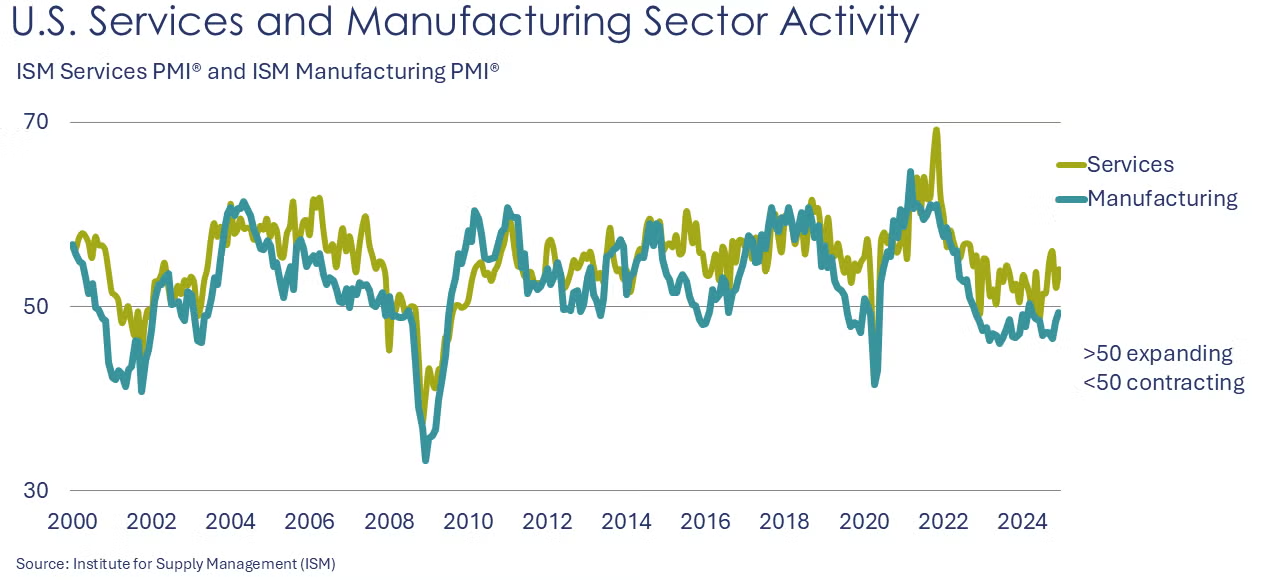
The services sector continued to expand at an accelerating pace in December. The ISM Services PMI® rose by 2.0 points to 54.1 with expansion in nine industries. Business activity/production and new orders rose at a faster rate. Employment and imports continued to expand at a slower pace, however. Export orders expanded, following a contraction in November. Order backlogs contracted and inventory sentiment remained “too high”.
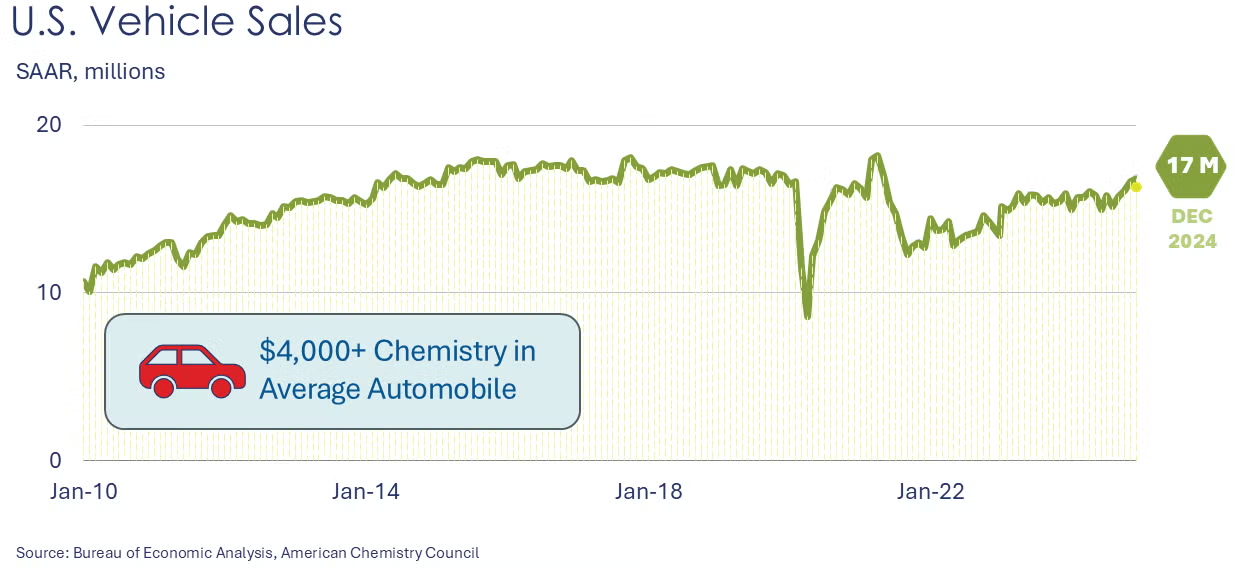
Light vehicle sales ended the year on a high note, increasing to a 16.8 million seasonally adjusted annual rate, the highest pace in 3½ years. The gain was driven by higher sales of the light-duty truck category.
Factory orders slipped in November, down 0.4%. There were declines in defense capital goods, consumer durables, IT equipment, and motor vehicles. Compared to a year ago, factory orders were down 2.8% Y/Y. Unfilled orders (a measure of the manufacturing pipeline) continued to expand, up by 0.3%. Manufacturing shipments edged slightly higher, up by 0.1% while inventories rose by 0.3%. The inventories-to-shipments ratio ticked higher to 1.47. Last November, the ratio was 1.48. Compared to a year ago, shipments were ahead by 0.1% while inventories were 0.4% higher.
ENERGY

- Oil prices were higher this week, in part due to an announced ban on US-sanction oil tankers by state-controlled Shandong Port group which controls several of China’s largest East Coast ports.
- U.S. natural gas prices edged a little higher in anticipation of a winter storm coming through the U.S. south over the next few days.
- The combined oil and gas rig count remained stable at 585 for a fourth consecutive week.
CHEMICALS
Indicators for the business of chemistry suggest a yellow banner, but with a greenish tint.
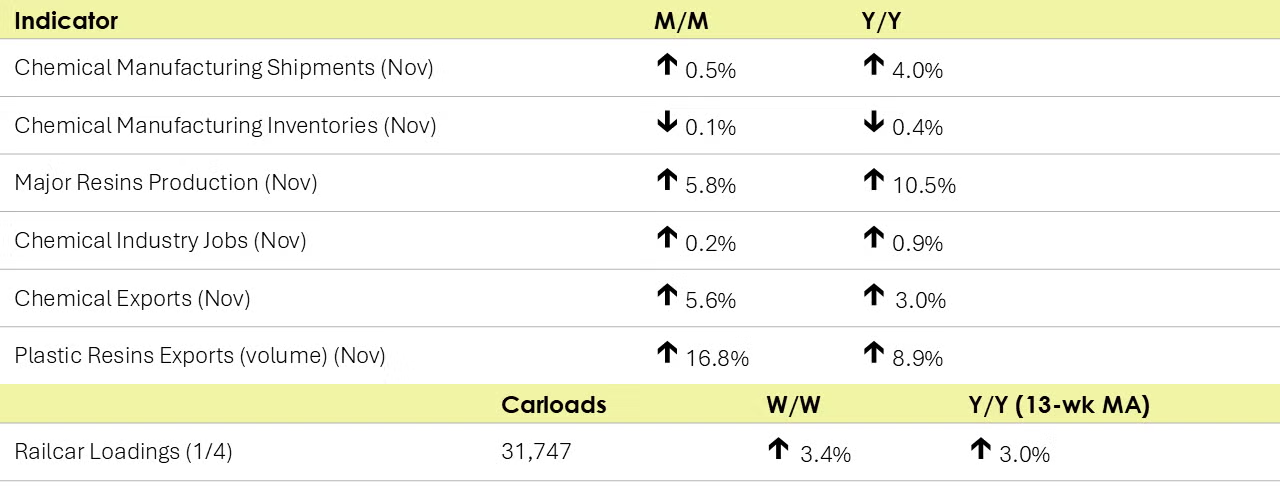
According to data released by the Association of American Railroads, chemical railcar loadings were up to 31,747 for the week ending January 4. Loadings were up 3.0% Y/Y (13-week MA), up (9.2%) YTD/YTD and have been on the rise for 7 of the last 13 weeks.
Chemical shipments rose for a second consecutive month in November, up by 0.5%, with gains across all major segments. Chemical inventories eased slightly, however, down by 0.1%. Lower inventories of agricultural chemicals offset higher inventories of coatings & adhesives. Inventories of other chemicals were essentially unchanged. The inventories-to-sales ratio fell from 1.18 in October to 1.17 in November. A year ago, the ratio was 1.22. Shipments were up 4.0% Y/Y while inventories were lower by 0.4% Y/Y.
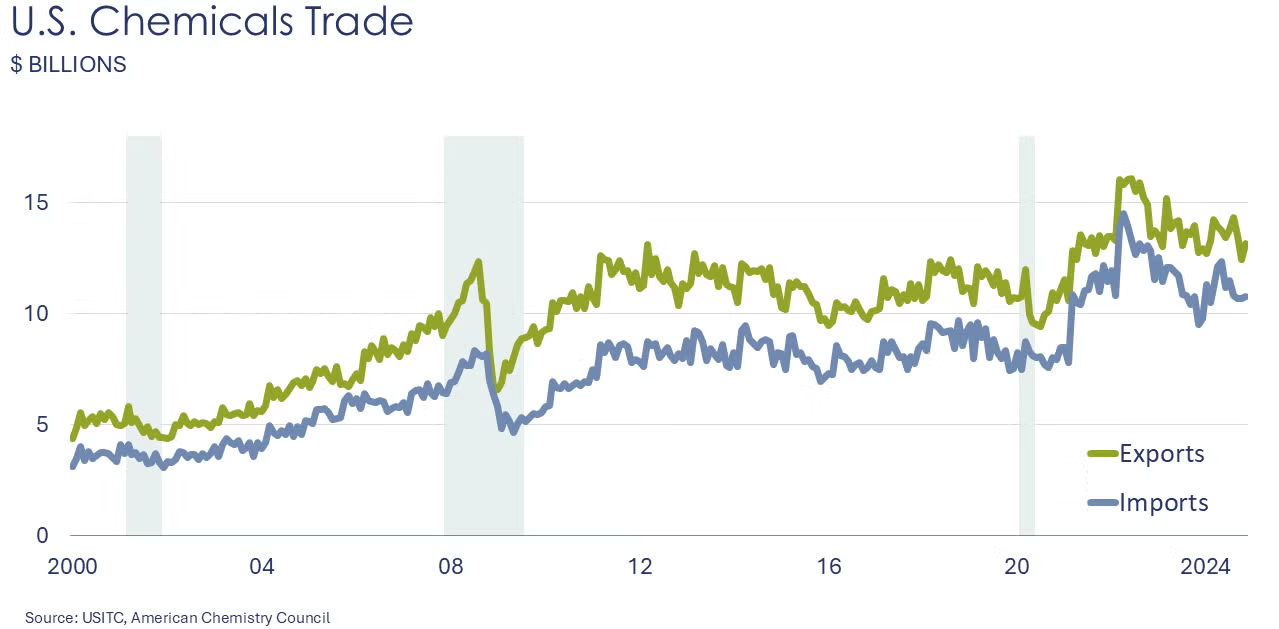
U.S. chemical exports were up 5.6% in November reflecting declines in all categories except adhesives and sealants and coatings. Chemical imports were up by 0.7% as a gain in inorganics offset declines in all other categories. The U.S. chemicals trade surplus rose to $2.4 billion in November and is $25.5 billion YTD. Compared to the same month last year, exports were up 3.0% Y/Y and imports were up 12.9% Y/Y.
U.S. plastic resins exports rose by 5.5% in November to a level up 3.9% Y/Y on a USD$ value basis. On a volume comparison, at 2.0 million metric tons exported in November, plastic resins exports were up 16.8% from October and up 8.9% Y/Y.
U.S. production of major plastic resins totaled 9.0 billion pounds during November 2024, an increase of 5.8% compared to the prior month, and an increase of 10.5% compared to the same month in 2023, according to ACC. Year-to-date production was 93.4 billion pounds, a 5.8% increase as compared to the same period in 2023.
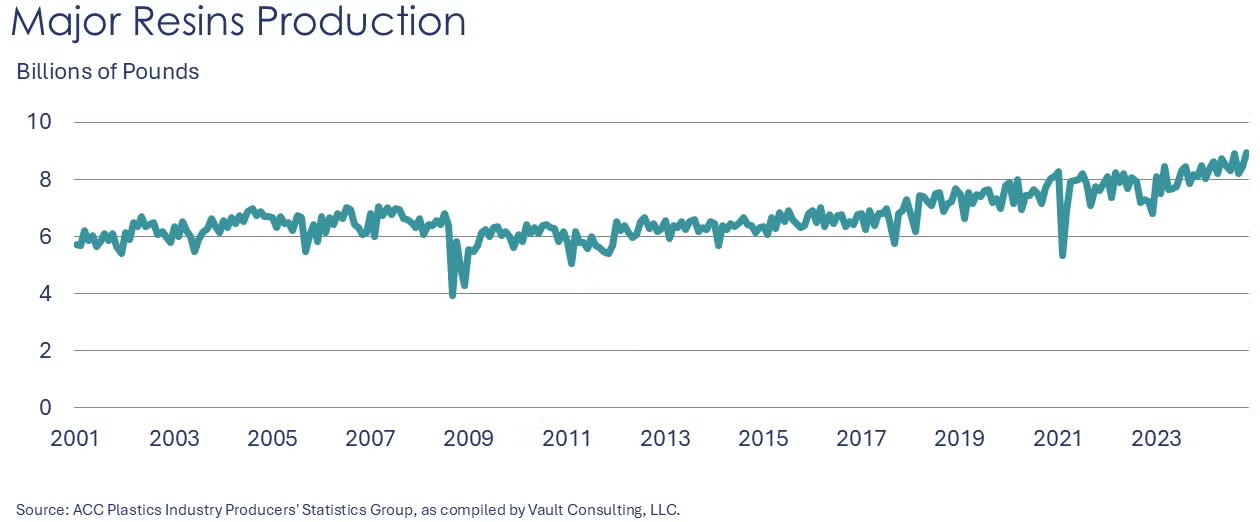
Sales and captive (internal) use of major plastic resins totaled 8.5 billion pounds during November 2024, an increase of 2.6% compared to the prior month, and an 8.6% increase from the same month one year earlier. Year-to-date sales and captive use were 92.3 billion pounds, a 5.9% increase as compared to the same period in 2023.
Chemical industry jobs rose 0.2% in November to 558,900, a level up 0.9% Y/Y. Employment in plastic resin manufacturing also edged higher by 0.2% to 61,6000, a level 1.0% lower than last November, however. (Note that data at the detailed industry level are lagged one month behind the headline jobs report.)
In December, combined chemical and pharmaceutical jobs continued to advance, up 0.1% to 904,000. A gain in production workers more than offset a decline in supervisory & non-production workers. Average hourly wages rose at a 2.1% Y/Y rate, the slowest annual increase in 2½ years. The average workweek rose by 18 minutes to 41.5 hours. Combined with the gain in production workers, this suggests that the labor input into the chemicals & pharmaceuticals industry rose, in contrast with last week’s ISM Manufacturing PMI® report.
Note On the Color Codes
Banner colors reflect an assessment of the current conditions in the overall economy and the business chemistry of chemistry. For the overall economy we keep a running tab of 20 indicators. The banner color for the macroeconomic section is determined as follows:
Green – 13 or more positives
Yellow – between 8 and 12 positives
Red – 7 or fewer positives
There are fewer indicators available for the chemical industry. Our assessment on banner color largely relies upon how chemical industry production has changed over the most recent three months.
For More Information
ACC members can access additional data, economic analyses, presentations, outlooks, and weekly economic updates through ACCexchange: https://accexchange.sharepoint.com/Economics/SitePages/Home.aspx
In addition to this weekly report, ACC offers numerous other economic data that cover worldwide production, trade, shipments, inventories, price indices, energy, employment, investment, R&D, EH&S, financial performance measures, macroeconomic data, plus much more. To order, visit http://store.americanchemistry.com/.
Every effort has been made in the preparation of this weekly report to provide the best available information and analysis. However, neither the American Chemistry Council, nor any of its employees, agents or other assigns makes any warranty, expressed or implied, or assumes any liability or responsibility for any use, or the results of such use, of any information or data disclosed in this material.
Contact us at ACC_EconomicsDepartment@americanchemistry.com.

